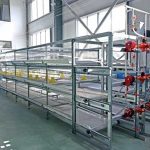3 factors you need to pay attention to of brooder cages for sale
- Humidity in brooder cages for sale
Humidity is very important to keep the flock healthy! We require at least 55% humidity in the early stage of brooding. This requires us to humidify at the same time as heating. In actual operation, sprinkling hot water on the ground is a simple and effective humidification method, and the automatic humidification effect of using a micro-hole spray pipe for irrigation is also very good. - Waterline trough (line) of brooder cages for sale
Clean and rinse the water line with trichloric (or dichloric) or hypochlorous acid before serving the chicken, or use an acidifier to keep each teat running smoothly. We once encountered the problem that the waterline of caged broilers was blocked on the second day because the waterline was not cleaned during the empty house period, resulting in dehydration of the chicks and serious losses.
The brooding water pressure can be maintained at 5-10 cm. If the adjustment is too high, the water pressure at the end of the chicken house may be too high, the chickens will have difficulty drinking water, and the feces will be thin in the manure belt. Except for the brooding layer, the other cage layers are closed.
Put clean drinking water into the water line to pre-warm 3 hours before the chicks arrive home, which can ensure that the chicks can drink about 25 degrees Celsius of drinking water after entering the cage to supplement the water lost during transportation.
The feed trough or feed line should be cleaned up, and no debris such as chicken feathers left in the previous batch should be left, and wiped and dried with disinfectant. Add the feed in advance, so that the chicks will have water to drink and food to eat when they come home.

- Temperature in brooder cages for sale
After we determine which layer of cage to brood, for example, we plan to brood in the middle layer, put the temperature probe on the level of the bottom net in the middle layer 5 cm or level with the back of the chicken. Be careful not to put the probe in the cage or As far as chickens can reach, out of reach of heating fans.
We generally set the brooding temperature at 33-35 degrees Celsius, first fully pre-warm the chicken house, and reduce the temperature to 28-30 degrees Celsius one hour before the chicks arrive home, so that the chicks can adapt to the temperature from the chick transporter to the chicken house. Change the temperature, then increase it by 1 degree Celsius every half an hour, increase it to the normal temperature within 2-3 hours, and then increase or decrease the temperature according to the performance of the flock.



